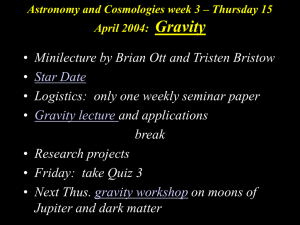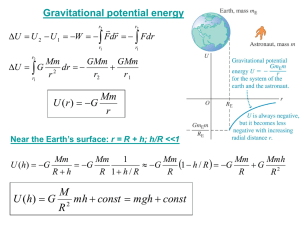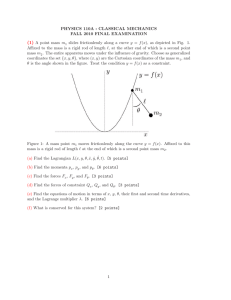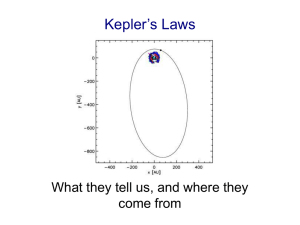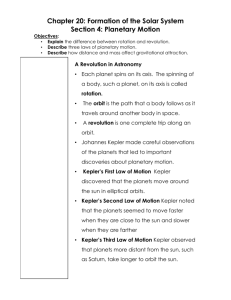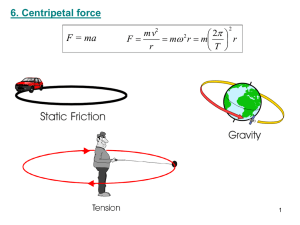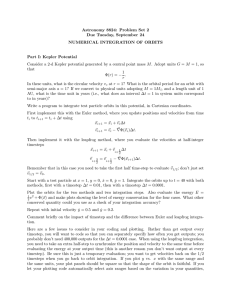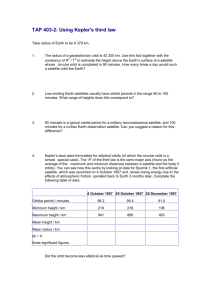Astro.A
advertisement
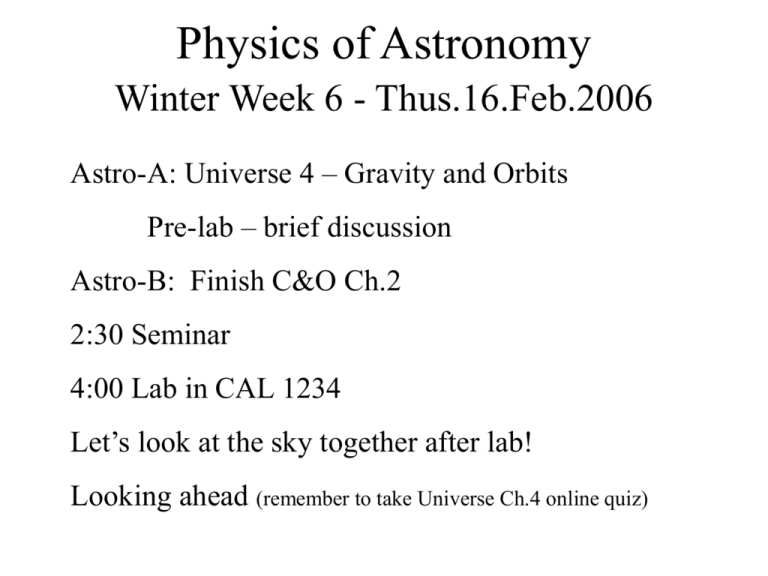
Physics of Astronomy Winter Week 6 - Thus.16.Feb.2006 Astro-A: Universe 4 – Gravity and Orbits Pre-lab – brief discussion Astro-B: Finish C&O Ch.2 2:30 Seminar 4:00 Lab in CAL 1234 Let’s look at the sky together after lab! Looking ahead (remember to take Universe Ch.4 online quiz) Astro-A: Universe 4 – Gravity & Orbits Ptolemy: Circular orbits about Earth Copernicus: Circular orbits about Sun Kepler: Elliptical orbits about Sun We derived Kepler’s 3d law from Newton’s 2d law: F=ma Gravitational force F=GmM/r2 acceleration in circular orbit a = v2/r Solve for v2: Speed v = distance/time = 2pr/T. Plug this into v2 and solve for T2: This is Kepler’s third law: T = period and r = orbit radius. For objects orbiting the Sun, Kepler’s law simplifies to a3 = p2, where a=radius in AU and p=period in years A satellite is placed in a circular orbit around the Sun, orbiting the Sun once every 10 months. How far is the satellite from the Sun? 2 10 a = p = _______ 12 3 2 a ______ Sidereal (real: P) and Synodic (apparent: S) periods: A satellite is placed in a circular orbit around the Sun, orbiting the Sun once every 10 months. How often does the satellite pass between the Earth and the Sun? 1 1 1 sidereal period Earth ' s sidereal year synodic period 1 1 1 P E S 1 1 1 10 1 S 12 1 ________________ S S ________________ We can use Newton’s gravity to approximate the size of a black hole! Knowing the gravitational force between two bodies m and M, we can find their gravitational energy: Energy Force * distance Egrav GmM * r ________ 2 r In order for an object (say, m) to escape M’s gravity, It needs sufficient kinetic energy K=1/2 mv2 … Use energy conservation to find the size of R of a black hole: Gravitational energy kinetic energy GmM 1 2 mv r 2 Solve for r ____________ Not even light can escape (v=c) if it is closer than r to a black hole. This is the Schwarzschild radius: R(for v=c) =_____________________ Lab height and speed vs time 25.00 20.00 15.00 height(m) Hand in before lab: • Excel practice results • Pre-lab speed(m/s) 10.00 5.00 0.00 0 0.5 1 1.5 2 2.5 tim e(s) Kinetic and Potential energy vs time 70 60 50 40 Kinetic(J) 30 Potential(m/s) 20 10 0 0 0.5 1 1.5 tim e(s) 2 2.5 Lab this afternoon • Read lab guidelines • Take notes in a bound notebook • Write up report this weekend Astro-B: C&O Ch.2: Gravity & orbits Kepler’s laws (for M>>m) Generalization (for M~m) K1: orbits are elliptical - about center of mass K2: equal areas in equal times - conservation of L K3: GMT 4p R 2 Center of mass Virial Theorem 2 3 G M m P2 4p 2 a3 Center of Mass reference frame Total mass = M = m1+ m2 Reduced mass = m m1m2 m m1 m2 Total angular momentum L=m r v = m rp vp (Pick any point, e.g. perihelion: rp and vp) p.50 L m GMa 1 e2 Virial Theorem <E> = <U>/2 where <f> = average value of f over one period For gravitationally bound systems in equilibrium, the total energy is always one-half of the potential energy. Ex: Use K3 in Eorbit = T + U for circular orbit: New HW: 2.8, 2.9 Looking ahead Monday Tuesday Wed Thus Fri

